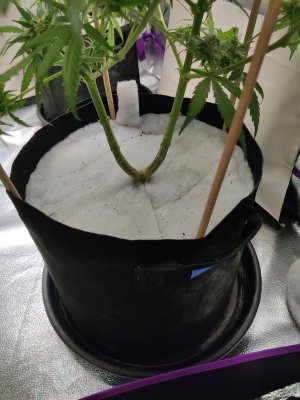- Joined
- Apr 14, 2023
- Messages
- 5,544
- Reaction score
- 34,202
Grow bags. Seems everyone’s experience is a bit different. Some run with it, other’s struggle the entire grow and hate them!
I love them and had to wonder why so many do not. Mainly it seems to all come down to watering practices and an understanding of the root zone.
Pros of the bags:
Allows light and air sheering of roots having outgrown the size of your container. This would occur in the same manner if this plant was planted in nature.
Does not allow the main tap root to hit a hard spot and snake or coil up in the bottom of your planter. When this happens the plant sends out a call for help. Your lady will respond sending all kinds of good stuff to the main root that thinks it’s in trouble. We need that good stuff up top!
call for help. Your lady will respond sending all kinds of good stuff to the main root that thinks it’s in trouble. We need that good stuff up top!
They are easily carried.
For chemical growers, they show what’s going on in your soil and will alert you to salt leeching.
They take minimal space for storage.
They can be washed and reused. (Empty, rinse dirt residue out,outside. Washer, using one cup of white vinegar and 1/4th cup of baking soda on a gentle cycle, remove, shape and allow to air dry)
Affordable
Cons:
Hard to water properly. This seems to be the number one problem and the one almost always mentioned. They (dried out cloth pots) seem to accompany many pics of sad droopy thirsty plants.
They dry out quickly. About three days max for me regardless of the humidity.
Improper watering allows pooling at the bottom of the root ball, allowing drowning to occur.
About Watering Cloth Pots:
This is no fast process! Watering cloth pots takes patience and time. If you are someone that just throws water at your plant and quickly moves on, this is not the container for you.
I water until the water slightly pools atop of the soil and then move on to the next while this “sinks in”. By the time I return to the plant I watered first, that has soaked in and I repeat this process. As the medium becomes willing to accept the water without pooling atop of the medium the process picks up a bit.
If I were to just dump a large amount of water atop of it, it would create channeling that would dump the watering right out the sides of my bag with all of it basically becoming runoff. You really want to allow time for that water to permeate the bag. That’s why I’m not satisfied until I see small drops from the bottom of the bag showing me that my medium is throughly watered. (I grow organically and don’t allow a big run off).
When watering a cloth bag the only time the center of the bag should be watered is at the time of transplanting to set your plant in. After that initial watering all watering is to be done in your root zone. To picture a root zone, look at your bag of soil, one inch from the rim of the bag picture a circle all the way around the pot. This will be your root zone. Watering in this area encourages your roots to spread out seeking water. Watering close to the root ball will build a mud hole beneath your plant cutting off oxygen and drowning it.
All in all for a bit of time in exchange for minimal storage, excellent growth and sticky fat buds.. I’m keeping mine
I love them and had to wonder why so many do not. Mainly it seems to all come down to watering practices and an understanding of the root zone.
Pros of the bags:
Allows light and air sheering of roots having outgrown the size of your container. This would occur in the same manner if this plant was planted in nature.
Does not allow the main tap root to hit a hard spot and snake or coil up in the bottom of your planter. When this happens the plant sends out a
They are easily carried.
For chemical growers, they show what’s going on in your soil and will alert you to salt leeching.
They take minimal space for storage.
They can be washed and reused. (Empty, rinse dirt residue out,outside. Washer, using one cup of white vinegar and 1/4th cup of baking soda on a gentle cycle, remove, shape and allow to air dry)
Affordable
Cons:
Hard to water properly. This seems to be the number one problem and the one almost always mentioned. They (dried out cloth pots) seem to accompany many pics of sad droopy thirsty plants.
They dry out quickly. About three days max for me regardless of the humidity.
Improper watering allows pooling at the bottom of the root ball, allowing drowning to occur.
About Watering Cloth Pots:
This is no fast process! Watering cloth pots takes patience and time. If you are someone that just throws water at your plant and quickly moves on, this is not the container for you.
I water until the water slightly pools atop of the soil and then move on to the next while this “sinks in”. By the time I return to the plant I watered first, that has soaked in and I repeat this process. As the medium becomes willing to accept the water without pooling atop of the medium the process picks up a bit.
If I were to just dump a large amount of water atop of it, it would create channeling that would dump the watering right out the sides of my bag with all of it basically becoming runoff. You really want to allow time for that water to permeate the bag. That’s why I’m not satisfied until I see small drops from the bottom of the bag showing me that my medium is throughly watered. (I grow organically and don’t allow a big run off).
When watering a cloth bag the only time the center of the bag should be watered is at the time of transplanting to set your plant in. After that initial watering all watering is to be done in your root zone. To picture a root zone, look at your bag of soil, one inch from the rim of the bag picture a circle all the way around the pot. This will be your root zone. Watering in this area encourages your roots to spread out seeking water. Watering close to the root ball will build a mud hole beneath your plant cutting off oxygen and drowning it.
All in all for a bit of time in exchange for minimal storage, excellent growth and sticky fat buds.. I’m keeping mine


